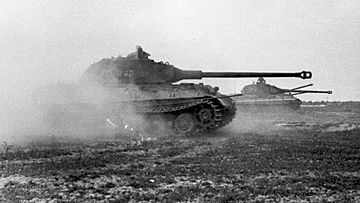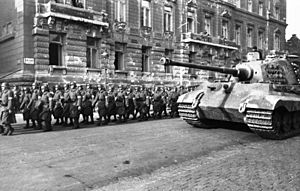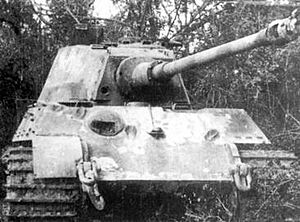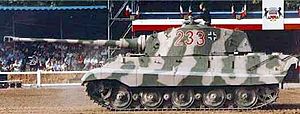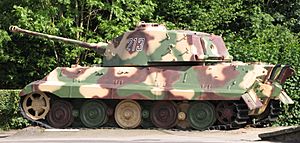Tiger II facts for kids
Quick facts for kids Panzerkampfwagen Tiger Ausf. B |
|
|---|---|
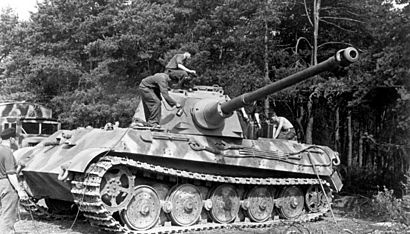
Tiger II, France, June 1944
|
|
| Type | Heavy tank |
| Place of origin | Nazi Germany |
| Service history | |
| In service | 1944–1945 |
| Wars | World War II |
| Production history | |
| Designer | Henschel & Son / Krupp (turret) |
| Designed | 1943 |
| Manufacturer | Henschel & Son / Krupp (turret) |
| Unit cost | 321,500 ℛℳ ($160,750 USD) in 1944–45 |
| Produced | 1944–45 |
| No. built | 492 |
| Specifications | |
| Mass | 68.5 tonnes (67.4 long tons; 75.5 short tons) early turret 69.8 tonnes (68.7 long tons; 76.9 short tons) production turret |
| Length | 7.38 m (24 ft 3 in) hull 10.286 m (33 ft 9.0 in) with gun forward) |
| Width | 3.755 m (12 ft 3.8 in) |
| Height | 3.09 m (10 ft 2 in) |
| Crew | 5 (commander, gunner, loader, radio operator, driver) |
|
|
|
| Armour | 25–185 mm (0.98–7.28 in) |
|
Main
armament |
1× 8.8 cm KwK 43 Early Krupp design turret: 80 rounds Production turret: 86 rounds |
|
Secondary
armament |
2× 7.92 mm MG 34 machine guns 5,850 rounds |
| Engine | V-12 Maybach HL 230 P30 petrol engine 700 PS (690 hp, 515 kW) |
| Power/weight | 10 PS (7.5 kW) /tonne (9.89 hp/tonne) |
| Transmission | Maybach OLVAR OG 40 12 16 B (8 forward and 4 reverse) |
| Suspension | Torsion bar |
| Ground clearance | 495 to 510 mm (19.5 to 20.1 in) |
| Fuel capacity | 860 litres (190 imp gal) |
|
Operational
range |
Road: 190 km (120 mi) Cross country: 120 km (75 mi) |
| Maximum speed | Maximum, road: 41.5 km/h (25.8 mph) Sustained, road: 38 km/h (24 mph) Cross country: 15 to 20 km/h (9.3 to 12.4 mph) |
The Tiger II was a very powerful heavy tank used by Nazi Germany during World War II. It was also known as the Königstiger, which means "King Tiger" in German. Allied soldiers often called it the King Tiger or Royal Tiger.
This tank was an improved version of the Tiger I. It combined the Tiger I's very thick armor with the sloped armor design seen on the Panther medium tank. The Tiger II was incredibly heavy, weighing almost 70 tons. Its front armor was between 100 and 185 millimeters thick. It carried a powerful, long-barreled 8.8 cm KwK 43 L/71 anti-tank cannon. The tank's main body was also used to create another vehicle, the Jagdtiger, which was a tank destroyer without a rotating turret.
The Tiger II tanks were given to special heavy tank groups in the German Army and the Waffen-SS. They first saw action in France during the invasion of Normandy on July 11, 1944. On the Eastern Front, the first Tiger IIs were used starting September 1, 1944.
Contents
Building the Tiger II Tank
The Tiger II was developed late in the war. Not many were built because of constant Allied bombing raids. Germany had planned to make 1,500 Tiger IIs, but only 492 were actually produced. Most of these were made in 1944 and 1945.
Making each Tiger II was a huge job. It took 300,000 hours of work and cost a lot of money. It was the most expensive German tank to produce at the time.
Tiger II Features and Design
The Tiger II had a crew of five: a commander, gunner, loader, radio operator, and driver. It was powered by a V-12 Maybach HL 230 P30 petrol engine, which gave it 700 horsepower. This allowed the tank to reach a maximum speed of about 41.5 kilometers per hour (26 mph) on roads.
Its main weapon was the 8.8 cm KwK 43 cannon. This gun could carry 80 to 86 rounds of ammunition. For defense, it also had two 7.92 mm MG 34 machine guns with 5,850 rounds.
The tank's armor was very thick, especially on the front. This made it very hard for enemy tanks to damage it from the front.
How Tiger II Tanks Were Used
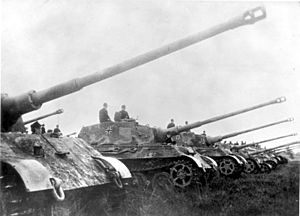
Tiger II tanks were mainly used by special heavy tank battalions in the German Army and the Waffen-SS. A typical battalion had 45 tanks.
Here's how a battalion was usually set up:
| Battalion command 3 × Tiger II |
||||||||
| 1st company command 2 × Tiger II |
2nd company command 2 × Tiger II |
3rd company command 2 × Tiger II |
||||||
| 1st platoon 4 × Tiger II |
2nd platoon 4 × Tiger II |
3rd platoon 4 × Tiger II |
1st platoon 4 × Tiger II |
2nd platoon 4 × Tiger II |
3rd platoon 4 × Tiger II |
1st platoon 4 × Tiger II |
2nd platoon 4 × Tiger II |
3rd platoon 4 × Tiger II |
Tiger II Reliability and Movement
When the Tiger II tanks were first made, they sometimes had problems. Things like leaking seals and issues with the steering could cause breakdowns. This happened because the tanks went into production without enough testing. Also, some drivers were not fully trained.
For example, one heavy tank battalion arrived on the Eastern Front with only 8 out of 45 tanks working. The first five Tiger IIs sent to another division broke down before they could even be used in battle.
However, engineers worked with the tank crews to fix these problems. With better parts and more training, the Tiger II became much more reliable. By March 1945, its reliability was similar to other German tanks like the Panzer IV.
Despite its heavy weight, the Tiger II was surprisingly easy to move around in battle. German records showed it could move as well as or even better than most other tanks of its time.
Tiger II in Combat
The Tiger II first saw combat on July 18, 1944, during the Battle of Normandy in France. On the Eastern Front, it was first used on August 12, 1944, near the Vistula River. In one early battle, three Tiger IIs were destroyed in an ambush by Soviet T-34-85s. Because ammunition explosions were a problem, the Germans later reduced the number of main gun rounds stored inside the turret.
In October 1944, Tiger IIs played a key role in Operation Panzerfaust in Budapest, Hungary. They helped German troops take control of the city. One battalion, the 503rd Heavy Panzer Battalion, fought in Hungary for 166 days. During this time, they claimed to have destroyed many Soviet tanks and guns. They lost 25 Tiger IIs, with most being destroyed by their own crews to prevent capture.
Many Tiger IIs were also used in the Ardennes Offensive in December 1944. About 150 Tiger IIs were involved, but most were lost during this battle.
Tiger IIs also fought in other major battles in 1945, including the Vistula–Oder Offensive, the East Prussian Offensive, the Lake Balaton Offensive, the Battle of the Seelow Heights, and the final Battle of Berlin.
Gun and Armor Power
The Tiger II's thick front armor and powerful, long-range gun gave it a big advantage. It was very difficult for any Allied or Soviet tank to destroy it from the front. This was especially true on the Western Front, where Allied forces did not have many heavy tanks.
Because of its strong front armor, enemies often had to try to attack the Tiger II from the sides or rear, where the armor was thinner. The Tiger II's main gun could destroy any Allied tank from over 2.5 kilometers away. This was much farther than most Allied tank guns could effectively shoot.
Soviet Testing of Captured Tiger IIs
In August 1944, the Soviets captured two Tiger II tanks near Sandomierz. They took them to a testing ground to study them. During the trip, the tanks had mechanical problems, like engines overheating.
The Soviets found that the Tiger II's 8.8 cm gun was very powerful and accurate. It could even shoot through another Tiger II's turret from 400 meters away. However, they also found that the welding on the armor was not as good as on earlier German tanks. Even if a shell didn't go through, pieces of metal could break off inside, damaging the tank. They also found that the armor plates themselves were not as strong as those on the Tiger I or Panther tanks.
Surviving Tiger II Tanks
Today, only one Tiger II tank is still able to move. It is displayed at the Musée des Blindés (Tank Museum) in Saumur, France. This tank was abandoned in August 1944 and later recovered by the French Army.
Other Tiger II tanks can be seen in museums around the world:
- The Tank Museum, Dorset, UK.
- Defence Academy of the United Kingdom, Shrivenham, UK.
- The Wheatcroft Collection, Leicestershire, UK (under restoration).
- Deutsches Panzermuseum, Munster, Germany.
- Kubinka Tank Museum, Russia.
- December 44 Museum, La Gleize, Belgium.
- National Armor & Cavalry Heritage Museum, Fort Benning, GA, United States.
- Schweizerisches Militärmuseum Full, Switzerland (under restoration).
Tanks Similar to the Tiger II
- British Black Prince heavy tank
- Soviet IS-2 model 1944 heavy assault tank
- Soviet IS-3 heavy tank
- United States M26 Pershing heavy tank
- French ARL 44
See also
 In Spanish: Panzer VI Tiger Ausf. B para niños
In Spanish: Panzer VI Tiger Ausf. B para niños



